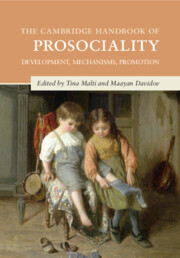Book contents
- The Cambridge Handbook of Prosociality
- Cambridge Handbooks in Psychology
- The Cambridge Handbook of Prosociality
- Copyright page
- Dedication
- Contents
- Figures
- Contributors
- Part I Development of Prosociality
- 1 Introduction: What Is Prosocial Development?
- 2 Developmental Theories of Prosociality
- 3 The Role of Genetics in the Development of Prosocial Behavior
- 4 Neurobiology of Prosociality
- 5 The Developmental Psychophysiology of Prosociality
- 6 The Origins of Prosociality from a Developmental and Comparative Perspective
- 7 Prosocial Behavior in Infancy and Early Childhood
- 8 Prosociality in Middle Childhood
- 9 Prosocial Behaviors in Adolescence
- 10 Prosocial Development across the Lifespan
- Part II Antecedents and Mechanisms of Prosociality
- Part III Development of Prosociality in Context
- Part IV Applications
- Index
- References
2 - Developmental Theories of Prosociality
from Part I - Development of Prosociality
Published online by Cambridge University Press: 25 May 2023
- The Cambridge Handbook of Prosociality
- Cambridge Handbooks in Psychology
- The Cambridge Handbook of Prosociality
- Copyright page
- Dedication
- Contents
- Figures
- Contributors
- Part I Development of Prosociality
- 1 Introduction: What Is Prosocial Development?
- 2 Developmental Theories of Prosociality
- 3 The Role of Genetics in the Development of Prosocial Behavior
- 4 Neurobiology of Prosociality
- 5 The Developmental Psychophysiology of Prosociality
- 6 The Origins of Prosociality from a Developmental and Comparative Perspective
- 7 Prosocial Behavior in Infancy and Early Childhood
- 8 Prosociality in Middle Childhood
- 9 Prosocial Behaviors in Adolescence
- 10 Prosocial Development across the Lifespan
- Part II Antecedents and Mechanisms of Prosociality
- Part III Development of Prosociality in Context
- Part IV Applications
- Index
- References
Summary
In this chapter, we review developmental theories of prosocial behavior. We begin by briefly discussing the ways in which the grand theories of development have been used to explain prosocial development, as well as some of the major biologically oriented arguments. We then present a comprehensive model of prosocial behavior that includes the multiple individual and contextual factors that contribute to prosocial actions in children. Next, we discuss the multidimensional nature of young children’s prosocial behavior – a topic of considerable research in the last decade – and suggest ways that the comprehensive model is relevant for prosocial development in very young children.
Keywords
- Type
- Chapter
- Information
- The Cambridge Handbook of ProsocialityDevelopment, Mechanisms, Promotion, pp. 17 - 36Publisher: Cambridge University PressPrint publication year: 2023
References
- 2
- Cited by

